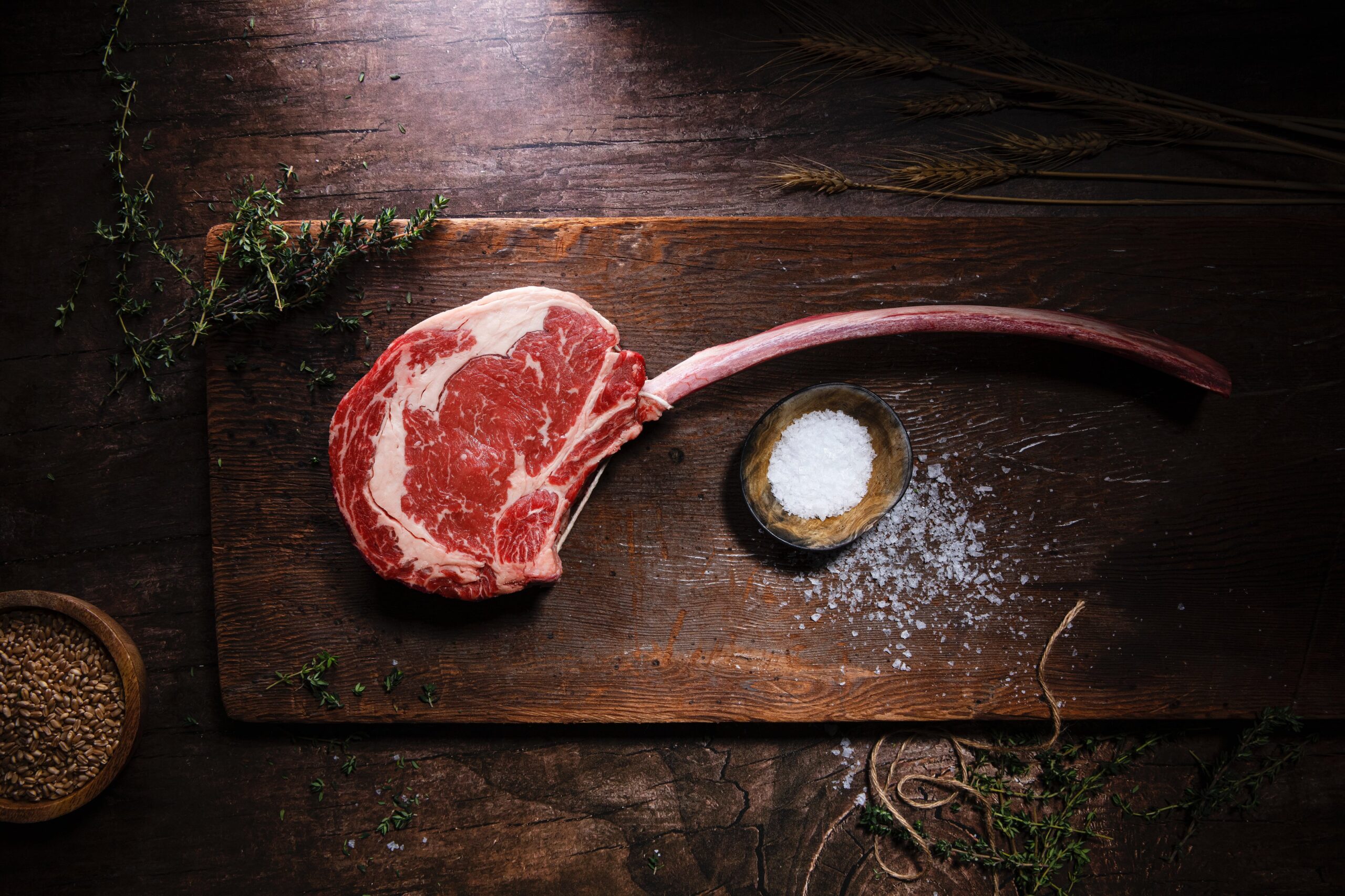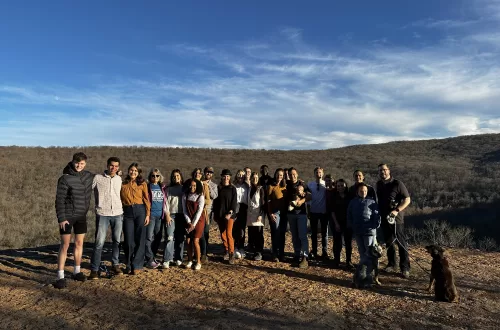As newlyweds, we didn’t realize the long-term impact small decisions would have on our family’s culture. We followed my mom’s simple advice to eat dinner at the table every night. Though many families share this tradition, one aspect of our family dinner is a little unique. When we pray and thank God for our food, we identify the protein by species and harvest location.
“Thank you Lord for this Arkansas buck and for the acorns that fed him!”
You see, my husband Clay came with his own traditions. Unlike me, he grew up in a hunting family and wanted to raise our family on wild game. I was not initially sold on the idea. My sole experience with wild game was smelly chili or smoked meat with a weird aftertaste at my friend’s house. But early in our marriage, I became convinced that high-quality protein would confer health benefits to both my family and our planet.
Why do we need meat?
Our bodies don’t make everything we need to live. Certain nutrients have to come from our diet. When people restrict meat, they have to supplement their diet with non-food sources to get the nutrients usually supplied by animal-sourced food. This is especially true for children, pregnant or lactating women, aging adults, and people who have chronic or acute diseases.
Most scientists believe that a nutrient-dense carnivorous diet is the reason we can support our large brains. It takes a lot to fuel these big ol’ human noggins. An estimated twenty percent of our calories go into fueling our huge brains. Breaking down fibrous plants is calorically taxing and humans have smaller guts than other primates who fill up on greens. This big brain / small gut combo explains why meat is such an important part of the human diet. Regardless of whether you believe humans evolved this way or that we were divinely designed this way, it’s hard to deny that meat is a crucial component of the human diet.
A year into our marriage Clay killed a buck and a bear. He processed, labeled, and optimistically stored the ground meat in one-pound packages in a freezer we financed from Sears. Not long after that, we found out that I was pregnant with our first child. We also learned that I was severely anemic. I needed a highly absorptive form of iron–and a lot of it. My body also needed a lot of protein to develop the growing baby I now supported. I appreciated meat’s efficiency in getting nutrients and protein to my body.
An Efficient Source of Iron
I quickly realized there’s a huge disparity in how much iron meat provides compared to other options. The doctor gave me a list of “high-iron” foods. Spinach was at the top of that list. When I crunched the numbers, I realized I would need to consume 4 cups of spinach to get the same amount of iron found in a 3-ounce serving of meat. Even then, the iron in spinach wouldn’t be readily absorbed by the body. Like many other vegetables and cereal grains, spinach has high levels of oxalates. These oxalates hinder the body from fully absorbing the iron it provides. As little as 2% of the iron in spinach is absorbed by the human body. These same issues plagued many of the items on the list the doctor gave me. But meat faithfully provided “low-drama”, easily-absorbed iron.
An Incredible Source of B Vitamins
Though meat makes up less than 10% of the world’s food mass, it delivers almost all of the global vitamin B12 intake and a significant portion of other vitamins and nutrients. Nearly all dietary intake of vitamin B12 comes from animal-sourced food. The B vitamins made easily accessible in a carnivorous diet are crucial for physical and cognitive development, normal blood function, neurological function, and immunity. That’s why it’s so important for women and children especially.
Importance for Women and Children
Meat eating is curiously stereotyped as a masculine activity (think Ron Swanson in Parks and Recreation). But it’s important at both an individual and societal level that women and children eat meat. Meat provides fat, protein, and other nutrients crucial for hormonal and reproductive health, physical development, and mental health.
As I ate more meat, I gained much-needed stability for my mood and blood sugar. I didn’t crave sweets and low-nutrient food as much. That’s because protein stabilizes blood sugar, reduces inflammation, and increases the production of neurotransmitters (like dopamine and serotonin). In other words, it makes you feel good.
Meat is so important that when it’s restricted, the impact is seen not only at an individual level. It is evident in national development metrics. There’s a link between the consumption of animal-sourced food and cognitive development, verbal ability, activity level, school performance, lifelong achievement, and overall economic productivity at a national level. Not to oversimplify it, but when women and children from low- and moderate-income countries eat meat, the kids are smarter, higher-achieving, and more financially productive. Even in high-income countries where undernutrition shouldn’t be an issue, restricting red meat is linked to iron deficiency and the problems that come with it.1
But isn’t meat bad for you and the planet?
Despite its benefits, carnivores have gotten a bad rap in recent years. Young people worry that meat is bad for our health and planet. Old folks worry about the link between red meat and heart disease due to its high fat content.
What’s the truth? Is meat a superfood or is it going to kill us? The answer isn’t yes or no. Some types of meat might kill you. Other types will actually protect you from heart disease, arthritis, and asthma. It helps if we first understand how the fatty acids in meat have changed as our “meat sourcing” has changed.
A Brief History of the Modern Diet
We can’t blame all the problems with the modern Western diet on meat or its inherent fatty acids. Historically hunters and gatherers have relied on meat for a nutrient-dense package of fat and vitamins. And though diabetes and heart disease were nearly non-existent in these ancient societies, nearly all of them would have exceeded today’s recommended guidelines for fat.
Contrary to what our mothers were told in the ‘80s, a healthy diet requires essential fats. Eating more–not less–of the right kind of fat can lower your cholesterol and risk of heart disease, improve brain function, and manage chronic diseases like arthritis, cancer, and autoimmune diseases. The amount of fat we eat is less important than the balance and quality of fat we eat.
The shift from a hunter-gatherer society toward an agricultural society led to a dependency on grain to feed both animals and humans. This shift resulted in iron deficiency, developmental delays, shrinking stature, and cavities. 2 The progression to the modern Western diet full of ultra-processed foods and factory-farmed meat increased the prevalence of “lifestyle diseases”. 3
Fatty Acid Content differs Based on Meat Procurement Practices
The meat that fueled our ancestor’s brains is different than the grain-fed meat sold in most grocery stores. The adage “you are what you eat” is true not only for humans, but for animals too. In the finishing phase of a cow’s life, 60–85% of the cow’s diet comes from corn. Consumption of grain-fed meat has some of the same disadvantages associated with grain-heavy diets. This diet, while very efficient at producing marbled beef, has a problematic omega-6: omega-3 ratio.
Not to be dramatic, but the ratio of omega-6 to omega-3 essential fatty acids is probably the most important aspect of your diet that you have never heard of. Our modern diet has excessive omega-6 polyunsaturated fats and a high omega-6/omega-3 ratio. Omega-6’s are connected to cardiovascular disease and autoimmune diseases. Omega-3’s suppress disease. An ideal ratio is 1. One omega-6 for every omega-3. Anything below 4 (4 omega-6:1 omega-3) is considered good.4
A quick review of the essential information: Omega-6 bad. Omega-3 good. The ratio of these two essential fatty acids is the dividing line between increased likelihood of modern diseases and decreased likelihood.
An omega 6:3 ratio under 4 is most similar to what our ancestors ate. The meat from grass-fed and foraging animals has a naturally occurring omega-6:3 ratio under 4 that provides important nutrients, improves brain function, lowers cholesterol, and lowers the risk of other chronic diseases.
The fat ratio of factory-farmed animals mass-produced in stockyards in the US ranges between 5:1 to 13:1. That’s a far cry from that optimal range. The consumption of fat that contains high amounts of saturated fatty acid and monounsaturated fatty acid is associated with adverse effects such as heart disease, obesity, and diabetes.
Winner, Winner Venison Dinner: Wild Game-the Fairest of them All
That fall when Clay harvested that buck and bear, he started a micro-marketing campaign aimed at an audience of one: me. He would brag about the merits of all that organic meat in our freezer as if creating ads for a health food store. Each time he defrosted a package, he made a persuasive appeal for me to partake in its nutrients.
And his marketing was accurate. The fact that the meat in our freezer had been harvested by my husband didn’t just provide a unique connection to our food or represent a tradition passed from one generation to the next. It represented a near-perfect ratio of fatty acids that provided essential nutrients and protection from heart disease, arthritis, diabetes, cancer, and asthma.
You would have a hard time creating a better balance of nutrients and essential fats in a lab than what you would find in most game harvested in the wild.5 The diverse consumption patterns and activity levels of wild animals result in meat with higher nutritional properties. When hunted properly, wild game experience less stress and thus have less adrenaline compared to animals raised in industrial breeding facilities. The fatty acid composition falls well within the range of optimal 1:1 to 4:1.6 (Wild boar and older brown bears have a ratio slightly above 4).
Similarly, pastured poultry and grass-fed beef have many of the same health benefits observed in wild game. They boast a healthier ratio of omega-6:omega-3 fats, lower saturated fat, and other nutritional advantages. These alternatives to factory-raised meats are increasingly available in mainstream supermarkets and local farmers markets.
Is meat good for the planet?
The merits of wild game and sustainable farming methods don’t end with nutritional value. These hunting and farming practices also blunt the impact of a meat eater’s diet on the environment. Wild game consumption is far better for the environment and has a lower energy value than farm-raised beef. From small-game hunting in the Amazon to the North American model of wildlife conservation, wild-game hunting plays a crucial role in securing our global food system, maintaining intact forests, and producing low-carbon sources of animal protein. Sustainable farmers can (and do)make similar claims.
Overcoming the Obstacles to Eating High-Quality Meat
Access to Quality Meat
In the absence of a resident hunter in your home or forest in your backyard, you might find it difficult to secure wild game. Not surprisingly, the people who are most likely to consume wild game are those with a family tradition connected to hunting. Many people are as unfamiliar as I was with wild game or have had bad experiences connected to the taste or smell of wild game.
Knowledge of how to Prepare Wild Game
It took a little bit of time to learn how to cook wild game in a palatable way. I started by using it as a substitute in recipes that called for ground beef. Clay will tell you we raised our family on the Big 5: Meatloaf, Nachos, Hamburgers, Spaghetti, and Chili. It wasn’t the fanciest or even the tastiest. But as college students raising our family on a tight budget, that buck and bear meat were worth their weight in gold. They brought benefits to our health and our grocery budget. My iron count went up and a family tradition was born.
Eventually, a wave of hunter chefs like Steve Rinella (the founder of MeatEater) and Austin-based chef and author Jessie Griffiths brought wild game preparation to a gourmet status. Their cookbooks took my culinary game to a whole new level.
Convenience of Wild Game
As we added children to our dinner table and began building each of our careers, taste was no longer the biggest challenge to putting wild game on our dinner table. Time and convenience were. Over time, I had to learn how to fit meat that is usually best slow-cooked into our very fast-paced, dual-career schedule. I learned some tricks to store, prep, and cook wild game or meat purchased from local farmers more efficiently. You can find some of those resources here.
The bear and that buck got our family through my pregnancy. We gave birth to a beautiful, healthy girl the following spring. Shortly after she was born, we took her on her first camping trip in the turkey woods where I became acquainted with one of my favorite sources of wild meat: the Eastern wild turkey. Soon after, three more beautiful children followed. Several of them became hunters and began contributing to the family stockpile of lean, organic meat. And eventually, we had to finance a second freezer to hold it all.






Thank you for this thoughtful article. Looking forward to looking at the recipes and reading more on this vein.
Thank you Chrystine! Look forward to connecting with you on here!
Thank you for this thoughtful article. Looking forward to looking at the recipes and reading more on this vein.